Related Research Articles

Clovis culture is a prehistoric Paleoamerican archaeological culture, named for distinct stone and bone tools found in close association with Pleistocene fauna, initially two Columbian mammoths, at Blackwater Locality No. 1 near Clovis, New Mexico, in 1936 and 1937, though Paleoindian artifacts had been found at the site since the 1920s. It existed from roughly 11,500 to 10,800 BCE near the end of the Last Glacial Period.
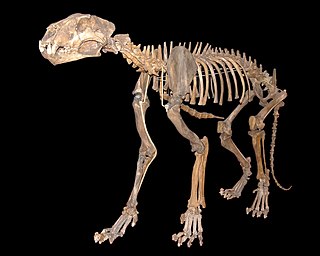
Panthera spelaea, also known as the cave lion or steppe lion, is an extinct Panthera species that most likely evolved in Europe after the third Cromerian interglacial stage, less than 600,000 years ago. Genetic analysis of ancient DNA has revealed that while closely related, it was a distinct species genetically isolated from the modern lion occurring in Africa and Asia, with the genetic divergence between the two species variously estimated between 1.9 million and 600,000 years ago. It is closely related and probably ancestral to the American lion. The species ranged from Western Europe to eastern Beringia in North America, and was a prominent member of the mammoth steppe fauna. It became extinct about 13,000 years ago.

The Columbian mammoth is an extinct species of mammoth that inhabited the Americas from southern Canada to Costa Rica during the Pleistocene epoch. The Columbian mammoth descended from Eurasian mammoths that colonised North America during the Early Pleistocene around 1.5–1.3 million years ago, and later experienced hybridisation with the woolly mammoth lineage. The Columbian mammoth was among the last mammoth species, and the pygmy mammoths evolved from them on the Channel Islands of California. The closest extant relative of the Columbian and other mammoths is the Asian elephant.
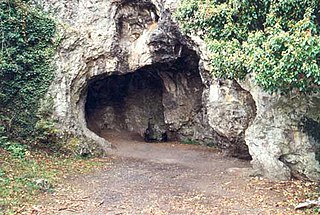
Spy Cave is located in Wallonia near Spy in the municipality of Jemeppe-sur-Sambre, Namur Province, Belgium above the left bank of the Orneau River. Classified as a premier Heritage site of the Walloon Region, the location ranks among the most significant paleolithic sites in Europe. The cave consists of numerous small chambers and corridors.
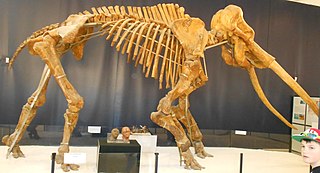
The straight-tusked elephant is an extinct species of elephant that inhabited Europe and Western Asia during the Middle and Late Pleistocene. It was larger than any living elephant, with adult males suggested to reach 3.81–4.2 metres (12.5–13.8 ft) in shoulder height, and 11.3–15 tonnes in weight. Like modern elephants, the straight-tusked elephant lived in herds, flourishing during interglacial periods, when its range would extend as far north as Great Britain. Skeletons found in association with stone tools and wooden spears suggest they were scavenged and hunted by early humans, including Neanderthals. It is the ancestral species of most dwarf elephants that inhabited islands in the Mediterranean.

Mammuthus meridionalis, sometimes called the southern mammoth, is an extinct species of mammoth native to Eurasia, including Europe, during the Early Pleistocene, living from around 2.5 million years ago to 800,000 years ago.
The Klasies River Caves are a series of caves located east of the Klasies River Mouth on the Tsitsikamma coast in the Humansdorp district of Eastern Cape Province, South Africa. The Klasies River Main (KRM) site consists of 3 main caves and 2 shelters located within a cliff on the southern coast of the Eastern Cape. The site provides evidence for developments in stone tool technology, evolution of modern human anatomy and behavior, and changes in paleoecology and climate in Southern Africa based on evidence from plant remains.
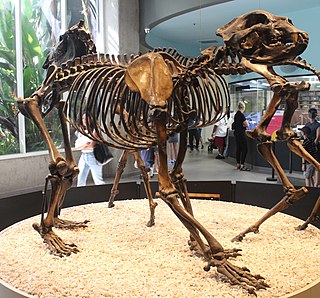
Arctodus is an extinct genus of short-faced bear that inhabited North America during the Pleistocene. There are two recognized species: the lesser short-faced bear and the giant short-faced bear. Of these species, A. simus was larger, is known from more complete remains, and is considered one of the most charismatic of North America's megafauna. A. pristinus was largely restricted to the Early Pleistocene of the Eastern United States, whereas A. simus had a broader range, with most finds being from the Late Pleistocene of the United States, Mexico and Canada. A. simus evolved from A. pristinus, but both species likely overlapped in the Middle Pleistocene. Both species are relatively rare in the fossil record.

Qesem cave is a Lower Paleolithic archaeological site near the city of Kafr Qasim in Israel. Early humans were occupying the site by 400,000 until c. 200,000 years ago.
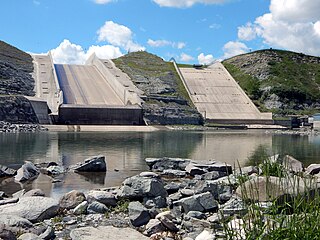
St. Mary Reservoir is a reservoir in southwestern Alberta, Canada. It was created for irrigation purposes by the damming of the St. Mary River, which was completed in 1951. The Kainai Nation's Blood 148 Indian reserve borders its northwest side. There are camping and picnic areas at the reservoir, and it is a popular site for power boating, water skiing, windsurfing, swimming and fishing.

Denisova Cave is a cave in the Bashelaksky Range of the Altai mountains, Siberian Federal District, Russia. The cave has provided items of great paleoarchaeological and paleontological interest. Bone fragments of the Denisova hominin originate from the cave, including artifacts dated to around 40,000 BP. Remains of a 32,000-year-old prehistoric species of horse have also been found in the cave.
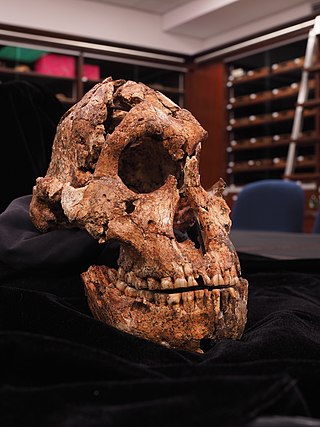
The Drimolen Palaeocave System consists of a series of terminal Pliocene to early Pleistocene hominin-bearing palaeocave fills located around 40 kilometres (25 mi) north of Johannesburg, South Africa, and about 6 kilometres (3.7 mi) north of Sterkfontein in the UNESCO World Heritage Site Cradle of Humankind.

The Rouffignac cave, in the French commune of Rouffignac-Saint-Cernin-de-Reilhac in the Dordogne département, contains over 250 engravings and cave paintings dating back to the Upper Paleolithic. In conjunction with other caves and abris of the Vézère valley, the Rouffignac cave was classified a Monument historique in 1957 and a World Heritage Site in 1979 by UNESCO as part of the Prehistoric Sites and Decorated Caves of the Vézère Valley.
Elands Bay Cave is located near the mouth of the Verlorenvlei estuary on the Atlantic coast of South Africa's Western Cape Province. The climate has continuously become drier since the habitation of hunter-gatherers in the Later Pleistocene. The archaeological remains recovered from previous excavations at Elands Bay Cave have been studied to help answer questions regarding the relationship of people and their landscape, the role of climate change that could have determined or influenced subsistence changes, and the impact of pastoralism and agriculture on hunter-gatherer communities.

Tam Pa Ling is a cave in the Annamite Mountains in north-eastern Laos. It is situated at the top of Pa Hang Mountain, 1,170 m (3,840 ft) above sea level.

The Vogelherd Cave is located in the eastern Swabian Jura, south-western Germany. This limestone karst cave came to scientific and public attention after the 1931 discovery of the Upper Palaeolithic Vogelherd figurines, attributed to paleo-humans of the Aurignacian culture. These miniature sculptures made of mammoth ivory rank among the oldest uncontested works of art of mankind. Because of the cultural importance of these sculptures and the cave's testimony to the development of Paleolithic art and culture, in 2017 the site became part of the UNESCO World Heritage Site called Caves and Ice Age Art in the Swabian Jura.

Pešturina is a cave in the municipality of Niška Banja in southeast Serbia. It is located southwest of Jelašnica and 20 km (12 mi) southeast of Niš. Artifacts from the Middle and Upper Paleolithic periods were discovered since the archaeological excavations began in 2006. The remains, identified as the Mousterian culture, were dated from 111,000 BP+ 5,000 to 39,000 BP + 3,000, which makes Pešturina one of the latest surviving Neanderthal habitats. The cave has been nicknamed the "Serbian Atapuerca".

Arago cave is a prehistoric site in the community of Tautavel, in the department of Pyrénées-Orientales. It is a large cavity overlooking a perennial stream called the Verdouble. Human remains attributed to the Tautavel Man and the lithic remnants of the Lower Paleolithic were discovered in the cave.
Porc-Epic Cave is an archaeological site located in Dire Dawa,Oromia, Ethiopia. Dated back to the Middle Stone Age, the site contains extensive evidence of microlithic tools, bone, and faunal remains. The lithic assemblage reveals that inhabitants at the time were well-organized with their environment. There is also rock art and strong evidence for ochre processing. The site was first discovered in 1920 by H. De Monfreid and P. Teilhard De Chardin. H. Breuil and P. Wernert performed the first excavation in 1933, followed from 1974 to 1976 by J. Desmond Clark and K.D. Williamson. Succeeding this was an excavation in 1998. Porc-Epic Cave provides insight into the behavior and technical capability of modern humans in eastern Africa during the Middle Stone Age.
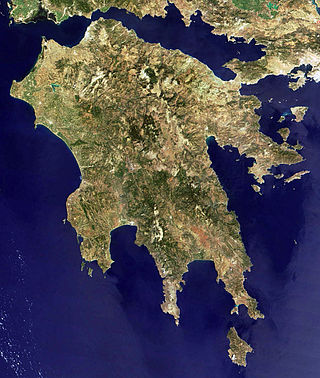
From the late 20th to the early 21st century, the Klissoura Cave 1 has been a site for archaeologists since its excavation. It is presumed that this area and site were in use for over 90,000 years.
References
- ↑ "Owl Cave Projectile Point". www.projectilepoints.net. Retrieved 2024-04-22.
- ↑ Calzada, Igor; Arranz, Iker (2022-11-02). "Western US Basque-American e-Diaspora: Action Research in California, Idaho, and Nevada". Societies. 12 (6): 153. doi:10.3390/soc12060153. ISSN 2075-4698.
{{cite journal}}: CS1 maint: unflagged free DOI (link) - ↑ Reid, Kenneth C. (July 2017). "Idaho beginnings: A review of the evidence". Quaternary International. 444: 72–82. doi:10.1016/j.quaint.2017.03.040. ISSN 1040-6182.
- ↑ Henrikson, L. Suzann; Byers, David A.; Yohe, Robert M.; DeCarlo, Matthew M.; Titmus, Gene L. (2017-06-27). "FOLSOM MAMMOTH HUNTERS? THE TERMINAL PLEISTOCENE ASSEMBLAGE FROM OWL CAVE (10BV30), WASDEN SITE, IDAHO". American Antiquity. 82 (3): 574–592. doi:10.1017/aaq.2017.14. ISSN 0002-7316.
- ↑ Karr, Landon P. (March 2015). "Human use and reuse of megafaunal bones in North America: Bone fracture, taphonomy, and archaeological interpretation". Quaternary International. 361: 332–341. doi:10.1016/j.quaint.2013.12.017. ISSN 1040-6182.
- ↑ Anderson, Steve F. (2021-07-06), "NEW (OLD) ONTOLOGIES OF DOCUMENTARY", Reclaiming Popular Documentary, Indiana University Press, pp. 356–370, retrieved 2024-04-01